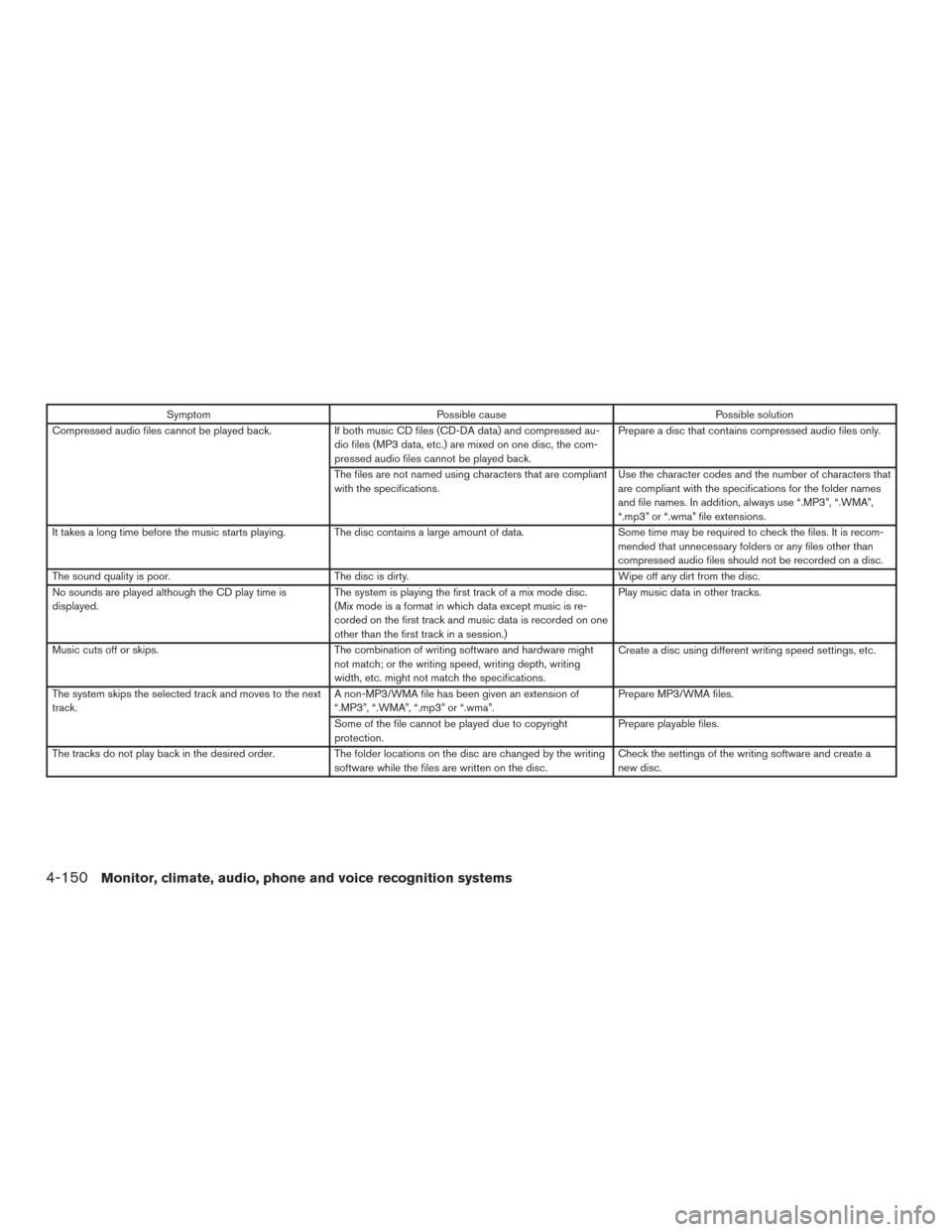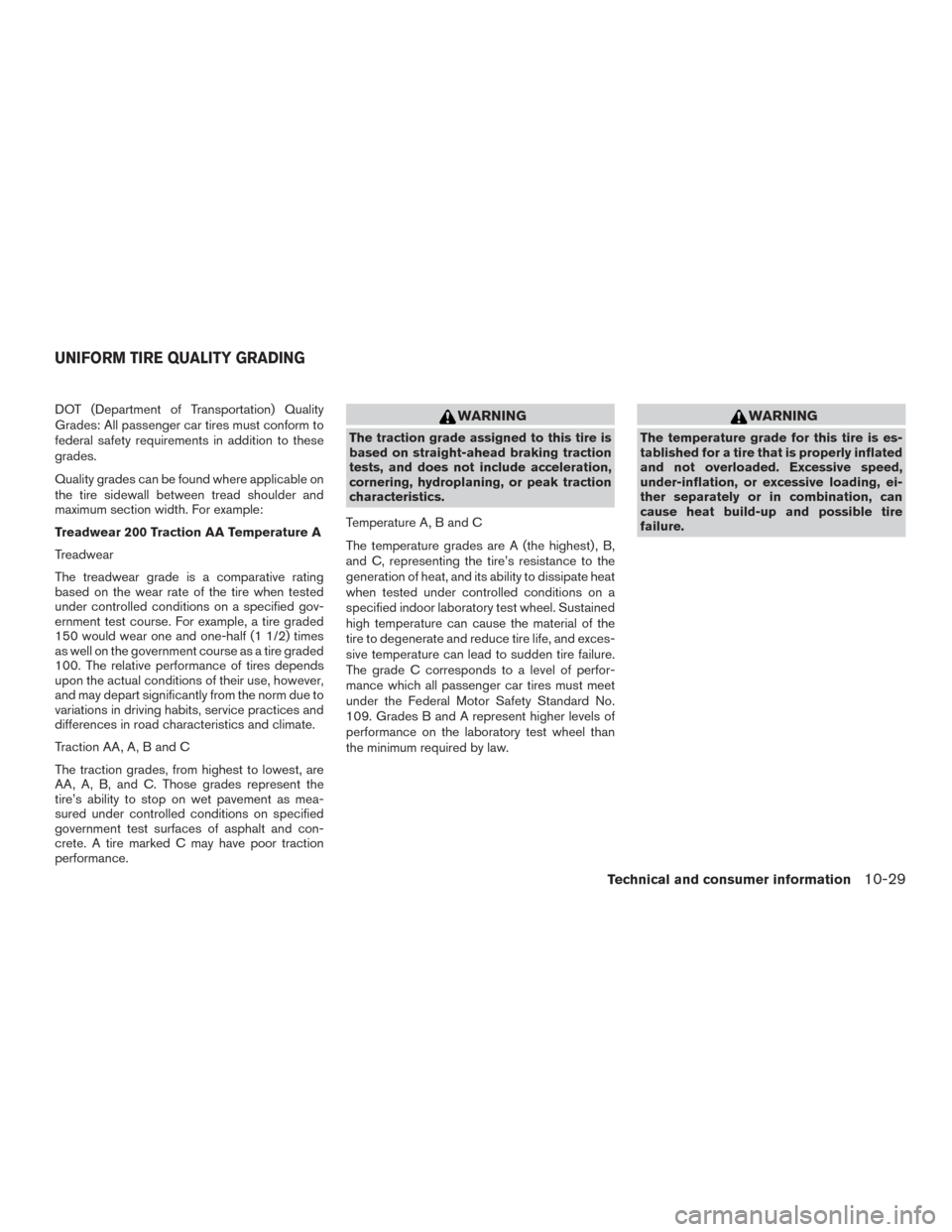Page 349 of 555

SymptomPossible cause Possible solution
Compressed audio files cannot be played back. If both music CD files (CD-DA data) and compressed au-
dio files (MP3 data, etc.) are mixed on one disc, the com-
pressed audio files cannot be played back. Prepare a disc that contains compressed audio files only.
The files are not named using characters that are compliant
with the specifications. Use the character codes and the number of characters that
are compliant with the specifications for the folder names
and file names. In addition, always use “.MP3”, “.WMA”,
“.mp3” or “.wma” file extensions.
It takes a long time before the music starts playing. The disc contains a large amount of data. Some time may be required to check the files. It is recom-
mended that unnecessary folders or any files other than
compressed audio files should not be recorded on a disc.
The sound quality is poor. The disc is dirty. Wipe off any dirt from the disc.
No sounds are played although the CD play time is
displayed. The system is playing the first track of a mix mode disc.
(Mix mode is a format in which data except music is re-
corded on the first track and music data is recorded on one
other than the first track in a session.) Play music data in other tracks.
Music cuts off or skips. The combination of writing software and hardware might
not match; or the writing speed, writing depth, writing
width, etc. might not match the specifications. Create a disc using different writing speed settings, etc.
The system skips the selected track and moves to the next
track. A non-MP3/WMA file has been given an extension of
“.MP3”, “.WMA”, “.mp3” or “.wma”. Prepare MP3/WMA files.
Some of the file cannot be played due to copyright
protection. Prepare playable files.
The tracks do not play back in the desired order. The folder locations on the disc are changed by the writing
software while the files are written on the disc. Check the settings of the writing software and create a
new disc.
4-150Monitor, climate, audio, phone and voice recognition systems
Page 384 of 555

●The RCTA system (if so equipped) is
integrated into the BSW system. There
is not a separate selection in the ve-
hicle information display for the RCTA
system. When the BSW is disabled, the
RCTA system is also disabled.
● When the BSW system is turned on, the
BSW/RCTA indicator (white) in the ve-
hicle information display illuminates.
BSW SYSTEM LIMITATIONS
WARNING
Listed below are the system limitations for
the BSW system. Failure to operate the
vehicle in accordance with these system
limitations could result in serious injury or
death.
●The BSW system cannot detect all ve-
hicles under all conditions.
● The radar sensors may not be able to
detect and activate BSW when certain
objects are present such as:
– Pedestrian, bicycles, animals.
– Vehicles such as motorcycles, low height vehicles, or high ground clear-
ance vehicles. – Oncoming vehicles.
– Vehicles remaining in the detection
zone when you accelerate from a
stop.
– A vehicle merging into an adjacent lane at a speed approximately the
same as your vehicle.
– A vehicle approaching rapidly from behind.
– A vehicle which your vehicle over- takes rapidly.
– A vehicle that passes through the de- tection zone quickly.
– When overtaking several vehicles in a row, the vehicles after the first ve-
hicle may not be detected if they are
traveling close together.
● The radar sensors’ detection zone is
designed based on a standard lane
width. When driving in a wider lane, the
radar sensors may not detect vehicles in
an adjacent lane. When driving in a nar-
row lane, the radar sensors may detect
vehicles driving two lanes away. ●
The radar sensors are designed to ig-
nore most stationary objects, however
objects such as guardrails, walls, foli-
age and parked vehicles may occasion-
ally be detected. This is a normal opera-
tion condition.
● The following conditions may reduce
the ability of the radar to detect other
vehicles:
– Severe weather
– Road spray
– Ice/frost/snow build-up on the vehicle
– Dirt build-up on the vehicle
● Do not attach stickers (including trans-
parent material) , install accessories or
apply additional paint near the radar
sensors. These conditions may reduce
the ability of the radar to detect other
vehicles.
● Excessive noise (for example, audio
system volume, open vehicle window)
will interfere with the chime sound, and
it may not be heard.
Starting and driving5-23
Page 490 of 555
�1Tire size (example: P215/65R15 95H)
1. P: The “P” indicates the tire is de- signed for passenger vehicles (not all
tires have this information) .
2. Three-digit number (215): This num- ber gives the width in millimeters of
the tire from sidewall edge to side-
wall edge.
3. Two-digit number (65): This number, known as the aspect ratio, gives the
tire’s ratio of height to width. 4. R: The “R” stands for radial.
5. Two-digit number (15): This number
is the wheel or rim diameter in inches.
6. Two- or three-digit number (95): This number is the tire’s load index. It is a
measurement of how much weight
each tire can support. You may not
find this information on all tires be-
cause it is not required by law. 7. H: Tire speed rating. You should not
drive the vehicle faster than the tire
speed rating.
Example
WDI0395
Do-it-yourself8-29
Page 522 of 555
WHEELS AND TIRES
WheelsOffset in (mm) Size
Alloy 1.97 (50) 18 x 7.5J
1.97 (50) 20 x 7.5J
Tires Size
All Season 235/65R18
235/55R20
Spare tire Wheel size Tire size
Temporary spare - steel 18 x 4T T165/90D18
DIMENSIONS AND WEIGHTS
Overall lengthin (mm)198.5 (5,042)
Overall width in (mm)77.2 (1,960)
Overall height without roof rack in (mm)69.6 (1,767.5)
with roof rack in (mm)70.2 (1,783.4)
Front and Rear Track in (mm)65.7 (1,670)
Wheelbase in (mm)114.2 (2,900)
Gross vehicle weight rating lb (kg) Refer to the “F.M.V.S.S./C.M.
V.S.S. certification label” on
the center pillar between the driver’s side front and rear doors.
Gross axle weight rating
Front lb (kg)
Rear lb (kg)
Technical and consumer information10-9
Page 542 of 555

DOT (Department of Transportation) Quality
Grades: All passenger car tires must conform to
federal safety requirements in addition to these
grades.
Quality grades can be found where applicable on
the tire sidewall between tread shoulder and
maximum section width. For example:
Treadwear 200 Traction AA Temperature A
Treadwear
The treadwear grade is a comparative rating
based on the wear rate of the tire when tested
under controlled conditions on a specified gov-
ernment test course. For example, a tire graded
150 would wear one and one-half (1 1/2) times
as well on the government course as a tire graded
100. The relative performance of tires depends
upon the actual conditions of their use, however,
and may depart significantly from the norm due to
variations in driving habits, service practices and
differences in road characteristics and climate.
Traction AA, A, B and C
The traction grades, from highest to lowest, are
AA, A, B, and C. Those grades represent the
tire’s ability to stop on wet pavement as mea-
sured under controlled conditions on specified
government test surfaces of asphalt and con-
crete. A tire marked C may have poor traction
performance.WARNING
The traction grade assigned to this tire is
based on straight-ahead braking traction
tests, and does not include acceleration,
cornering, hydroplaning, or peak traction
characteristics.
Temperature A, B and C
The temperature grades are A (the highest) , B,
and C, representing the tire’s resistance to the
generation of heat, and its ability to dissipate heat
when tested under controlled conditions on a
specified indoor laboratory test wheel. Sustained
high temperature can cause the material of the
tire to degenerate and reduce tire life, and exces-
sive temperature can lead to sudden tire failure.
The grade C corresponds to a level of perfor-
mance which all passenger car tires must meet
under the Federal Motor Safety Standard No.
109. Grades B and A represent higher levels of
performance on the laboratory test wheel than
the minimum required by law.
WARNING
The temperature grade for this tire is es-
tablished for a tire that is properly inflated
and not overloaded. Excessive speed,
under-inflation, or excessive loading, ei-
ther separately or in combination, can
cause heat build-up and possible tire
failure.
UNIFORM TIRE QUALITY GRADING
Technical and consumer information10-29